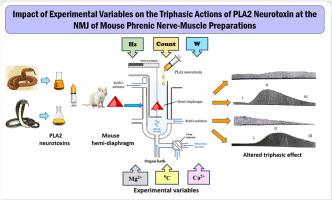The impact of experimental variables in twitch tension recording on triphasic action of phospholipase A2 neurotoxins at the neuromuscular junction and acetylcholine release
IF 2.4
4区 医学
Q2 PHARMACOLOGY & PHARMACY
引用次数: 0
Abstract
Electrophysiological investigations have previously demonstrated that snake venom phospholipase A2 (PLA2) neurotoxins such as β-bungarotoxin (BuTx), taipoxin, notexin, crotoxin, and ammodytoxin (Amtx), exert a triphasic effect on the release of acetylcholine (ACh) at the neuromuscular junction (NMJ). The first phase is characterized by a transient decrease in twitch height, which is followed by a facilitatory phase during which twitch height exceeds control levels. The final phase is a reduction of twitch height, ultimately leading to paralysis. The manifestation of this triphasic effect occurs under specific experimental conditions.
This study aims to investigate these “specific conditions” and how various experimental variables can influence the twitch tension recordings and their effect on the modulation of the triphasic action of the aforementioned PLA2 neurotoxins at the NMJ, and their impact on ACh release. These variables include factors such as the concentration of Mg2+ and Ca2+, temperature, stimulation frequency, toxin concentration, washout procedures, interactions between toxins, animal weight, and the presence of 3,4-diaminopyridine (3,4-DAP) and tetraethylammonium (TEA).
In conclusion, this research highlights that the triphasic action of PLA2 neurotoxins at the NMJ is not a fixed phenomenon but can be substantially modulated by changes in experimental conditions. These findings emphasize the importance of carefully considering experimental parameters when studying the effects of PLA2 neurotoxins. Variations in conditions may influence responses and impact the interpretation of underlying neurotoxic mechanisms.

抽搐张力记录实验变量对神经肌肉接点磷脂酶A2神经毒素三相作用及乙酰胆碱释放的影响
电生理研究表明,蛇毒磷脂酶A2 (PLA2)神经毒素如β-兔毒素(BuTx)、taipoxin、notexin、crotoxin和ammodytoxin (Amtx)对神经肌肉连接处(NMJ)乙酰胆碱(ACh)的释放有三相作用。第一阶段的特征是抽搐高度的短暂下降,随后是抽搐高度超过控制水平的促进阶段。最后一个阶段是抽搐高度的降低,最终导致瘫痪。这种三相效应的表现是在特定的实验条件下发生的。本研究旨在探讨这些“特定条件”,以及各种实验变量如何影响抽搐张力记录及其对上述PLA2神经毒素在NMJ的三相作用调节的影响,以及它们对乙酰胆碱释放的影响。这些变量包括诸如Mg2+和Ca2+浓度、温度、刺激频率、毒素浓度、冲洗程序、毒素之间的相互作用、动物体重以及3,4-二氨基吡啶(3,4- dap)和四乙基铵(TEA)的存在等因素。总之,本研究强调PLA2神经毒素在NMJ的三相作用不是一个固定的现象,而是可以通过实验条件的变化进行实质性的调节。这些发现强调了在研究PLA2神经毒素的作用时仔细考虑实验参数的重要性。条件的变化可能影响反应并影响对潜在神经毒性机制的解释。
本文章由计算机程序翻译,如有差异,请以英文原文为准。
求助全文
约1分钟内获得全文
求助全文
来源期刊

Toxicon
医学-毒理学
CiteScore
4.80
自引率
10.70%
发文量
358
审稿时长
68 days
期刊介绍:
Toxicon has an open access mirror Toxicon: X, sharing the same aims and scope, editorial team, submission system and rigorous peer review. An introductory offer Toxicon: X - full waiver of the Open Access fee.
Toxicon''s "aims and scope" are to publish:
-articles containing the results of original research on problems related to toxins derived from animals, plants and microorganisms
-papers on novel findings related to the chemical, pharmacological, toxicological, and immunological properties of natural toxins
-molecular biological studies of toxins and other genes from poisonous and venomous organisms that advance understanding of the role or function of toxins
-clinical observations on poisoning and envenoming where a new therapeutic principle has been proposed or a decidedly superior clinical result has been obtained.
-material on the use of toxins as tools in studying biological processes and material on subjects related to venom and antivenom problems.
-articles on the translational application of toxins, for example as drugs and insecticides
-epidemiological studies on envenoming or poisoning, so long as they highlight a previously unrecognised medical problem or provide insight into the prevention or medical treatment of envenoming or poisoning. Retrospective surveys of hospital records, especially those lacking species identification, will not be considered for publication. Properly designed prospective community-based surveys are strongly encouraged.
-articles describing well-known activities of venoms, such as antibacterial, anticancer, and analgesic activities of arachnid venoms, without any attempt to define the mechanism of action or purify the active component, will not be considered for publication in Toxicon.
-review articles on problems related to toxinology.
To encourage the exchange of ideas, sections of the journal may be devoted to Short Communications, Letters to the Editor and activities of the affiliated societies.
 求助内容:
求助内容: 应助结果提醒方式:
应助结果提醒方式:


